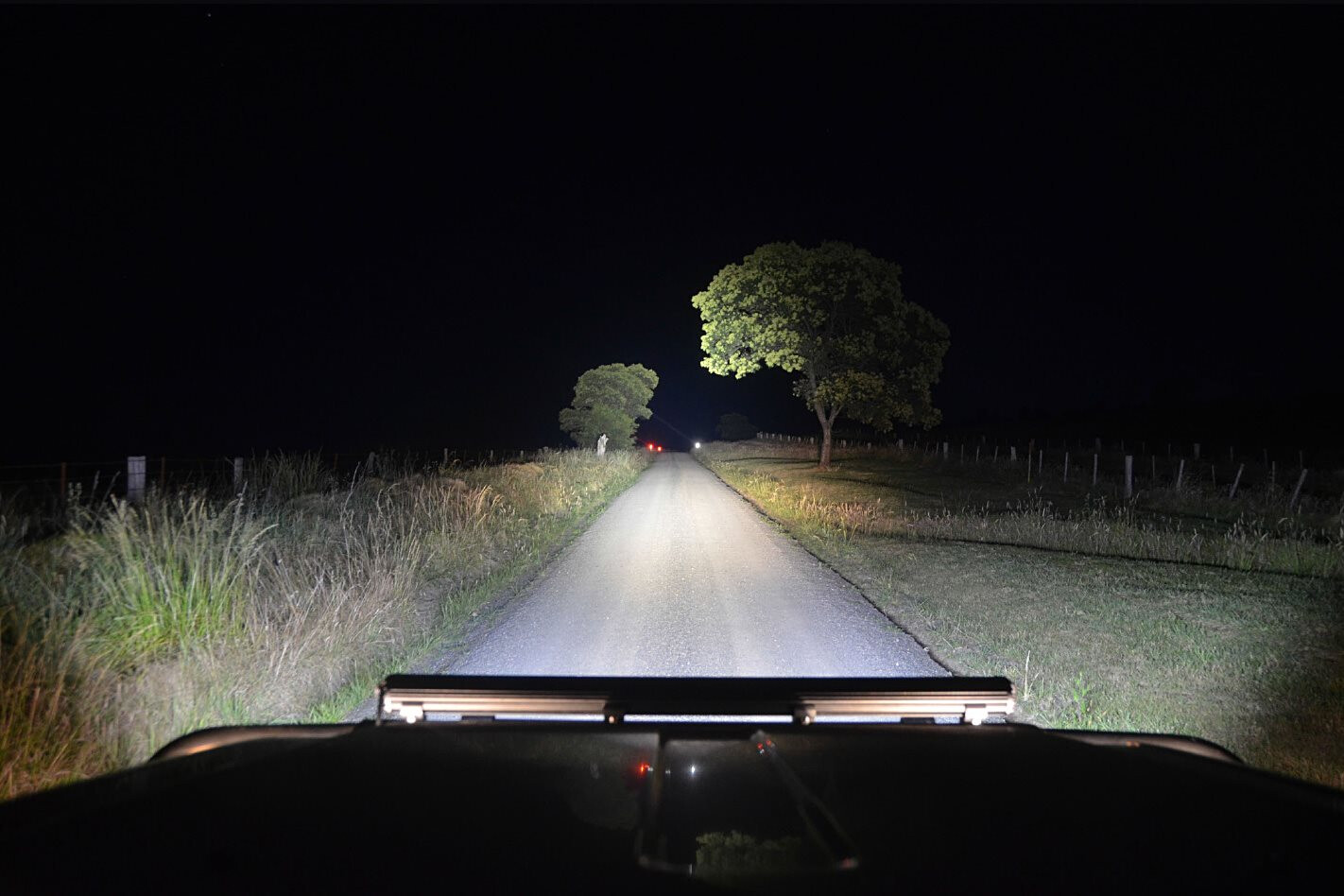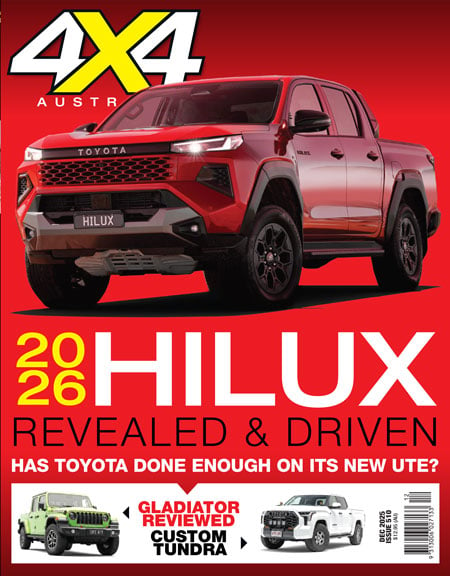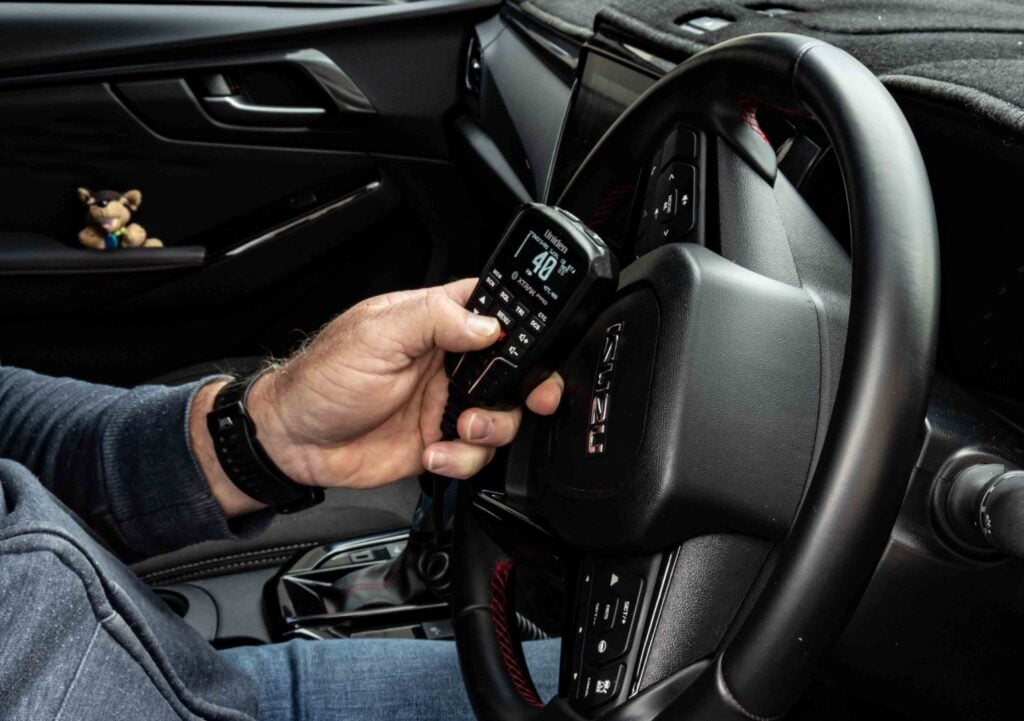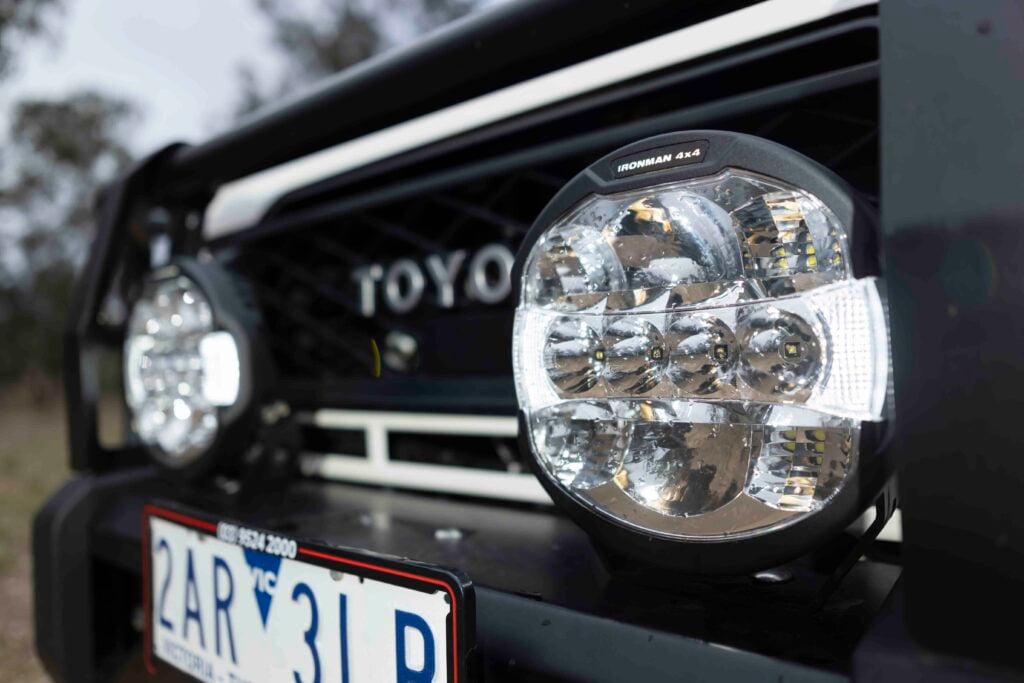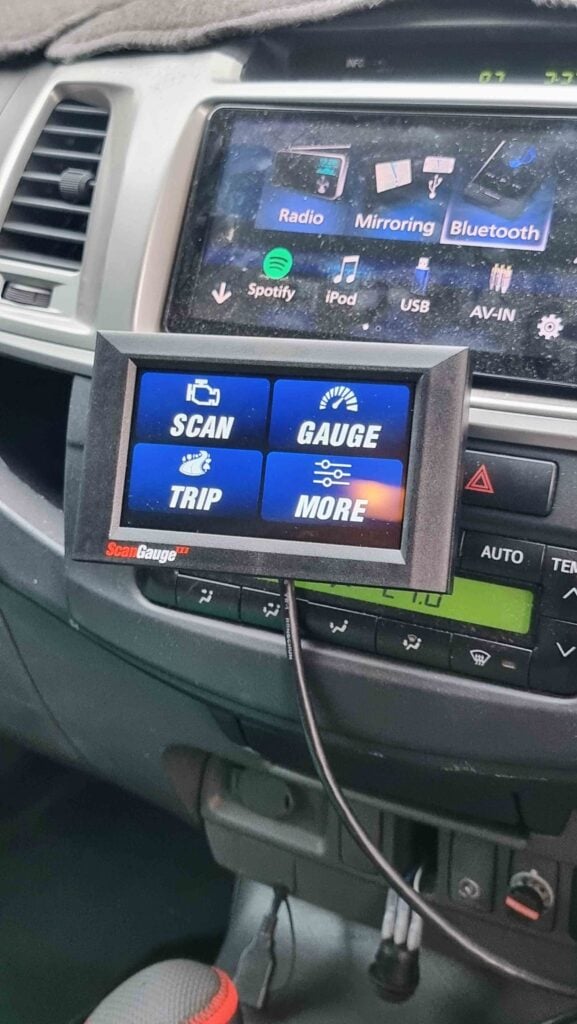Not so long ago, when looking for driving lights, the only choice you had were halogen lights. Sure, you got to wrack your brain deciding on a pencil or spread beam and whether to ‘up’ the bulbs from 100 to 130 watt in some brands. Life was easy.
This article was originally published in the August 2014 issue of 4×4 Australia.
Nowadays, there’s endless choice on offer in the lighting scene. You still get to choose pencil or spread beams, but how much of each do you need or want; 10 degrees, 20 degrees or up to (almost) 180 degrees of light throw. If you ticked the pencil beam box, how far do you really want to see ahead; 500 metres, 800 metres or is it really necessary to see 2000 metres down the track? Mind-boggling stuff and pretty much anything is available, depending on how deep your pockets are.
To increase the brain strain, add the need to choose between old school halogen (quartz halogen is simply a quartz glass bulb with halogen gas inside) beams, high intensity discharge (HID, or known as Xenon by some; it’s still a quartz glob but filled with Xenon gas), or the latest type – light emitting diode (LED).
If you are new to all this, you may well scoff at utilising LEDs to light the road ahead, rather believing that those tiny LEDs are only used in handheld appliances or as tell-tale lights. Nothing could be further from the truth, as the clever clogs in the lighting industry have managed to pack enough punch into an LED driving light to well and truly light your path into the great unknowns of any road or track.
Did we mention you also have a choice between 35 watt and 50 watt in the HID option as well as sometimes a light colour choice from 4200 to 6000 Kelvin, or 3900, 5900, 9800 or 17600 Lumens if ticking the LED box. How’s that for information overload?
For the sake of this article, and to ensure we don’t overwork your brains, we’ll keep things as simple as possible and demonstrate via real life testing with a few techo measurements thrown in to be doubly sure we’re not leading anyone astray.
PROS AND CONS In surmising the for and against, you, the driver, will have to make the final decision on which light works best for you based on performance in length or width, longevity of bulb or even purely based on price. Here’s a rundown on our experiences over the years, plus the results of this testing.
Halogen: Being the oldest form of forward driving lights (readily available), you don’t need to look any further if you’re looking at doing the least damage to your bank balance. While they are the lowest price, don’t discount their superiority over OEM headlights.
Many travellers have lapped Australia and had to endure the occasional blown bulb (which is easily and cheaply replaced), put up with the yellowish light output and make sure they don’t exceed the alternator output. I spent close to 20 years ‘putting up with’ halogens and that included a stint around Australia for 24 months in which I replaced the bulbs (with the cheapest ones I could find at the time) only a hand full of times.
Given their shortcomings, halogen lights can still cast a decent length and width of beam. It’s also easy to up the wattage to 130 or even 150 (provided your casing, lens, reflector, alternator and wiring are all up to the task), or try playing with different coloured bulbs or covers for a bluish appearance if you must.
HID: The step up in cost and outright light brilliance are the major factors with HID lights. While prices have plummeted since their introduction (from thousands per light to hundreds per pair of lights) they are still significantly dearer than halogen lights.
The next big improvement is the bulb life expectancy of over 7000 hours; however, it’s not unheard of for them to blow with much less use than that. The HIDs lower current draw is also significant, given they are driven by 35 or 50 watt systems. One of the drawbacks that detractors always cling to is the ‘warm up’ time: there can be (depending on type of ballast) five to 10 seconds until the bulbs reach their maximum intensity. That being said, the latest ballasts have less initial warm up time, followed by (practically) none once your lights have been dipped for oncoming traffic, then switched on again.
Possibly of most concern is the blinding glare from the lights for both oncoming traffic and the driver. Having driven with HIDs for around seven years, the reflection of road side signs is so great that I frequently dip the lights while passing them.
LED: Given the relative ‘newness’ of using LED lights on front facing driving, there are many detractors. Indeed the earliest LED driving lights were pretty crap compared to those available on the market today, and most of them didn’t cast much light along the road.
Rather, they have mostly been regarded as a wide-beam-only lighting system. Compared to the long-casting HID systems, that was pretty much the summery of LEDs – wide not far. But believe me, you’d be surprisingly happy travelling about rural roads with some of the later types of medium length LED bars.
As mentioned, I’ve been lucky enough to have driven thousands of kilometres with HIDs, but have also been graced with two medium LED light bars for the last two years. Not as a replacement to the HID, but as an addition. It’s given me a much wider and more evenly lit field of view when all four lights are on. I’ve also tried driving with just the LEDs (HIDs turned off) and other than that outright reach of light, I was perfectly happy around town and the back blocks, although a larger bar (higher lumen output) would be preferable.
LEDs excel in lower currant draw, have no warm up time, have a massive (many say more than 50,000 hours) life expectancy and therefore no need to replace globes. Given their natural tendency to ‘spread’ or ‘scatter’ light rather than ‘direct’ it has more recently seen a concerted effort to manufacture a true spot beam as compared to the LEDs excellent spread beam pattern. Total waterproofness and vibration resistance see the LED jumping leaps and bounds ahead of all others in longevity, now we just need to see that usual trend of price decreasing with time on the market.
Another noteworthy attribute regarding the ‘light scattering’ effect of LEDs is the ability to spread in both the vertical and the horizontal plain. While most bang on about ‘width of beam’, many forget about the benefits of having a greater ‘height of beam’ – we want to see the undulating, pot-holed track ahead at all times, even when the front of your 4×4 dips and mounts everything in its path.
Given prior use and current testing of these NARVA units, it’s clear they can be used as a spot driving light instead of just a spread. Sure they can’t match outright distance of the HID spot, but crikey, there’s not much you’d miss on the tracks with them.
Given my time again, I’d still say the all round pick of a combination of HIDs for maximum distance down the road, with either one long LED bar or two medium length units to spread the light as wide as possible in the near to midrange distance would be my combination of choice.
Then again, there are some exciting new LED lights that have been released, plus a few that are about to enter the market, so keep watching this space as we round up all the best LED lighting options for a future article. This could be enough to change my mind about lighting altogether and ditch all other systems completely.
FAIR PLAY THANKS To be sure we are comparing apples with apples, as much as possible; we’ve given the nod to NARVA to supply all the required lights this time around. This ensures we are getting equal quality across the board, equal dimensions within the chosen light types – as in the same diameter halogen and HID is available in their range – and we managed to convince them to supply wiring looms to suit all lights to enable quick and easy light changing. If you’d like to see the complete range of NARVA lighting, check out the Narva website.
CHOICES GALORE While sieving through the NARVA range of lights, we quickly became aware of the extent of our choices – it actually managed to make our testing regime larger and better for it. So rather than choosing one set of each type of lighting; we went for two of everything – a double burger, or upsized, test you might say.
In the halogen range we went for the large 225 Ultima 100W combo kit, as well as the smaller diameter Ultima 175 combo kit. That would not just show if size really does matter, but also the differences between older style lens-optic lights (Ultima 175) compared to free form reflectors (Ultima 225).
Then, when we looked at their HID catalogue, we found we had the choice of 35 watt and 50 watt spots and spread – we went with one of each to see if we could pick the difference in light outputs from the different wattage lights.
The LED range was even larger, so we went for the smallest NARVA light bar at 3900 Lumens with eight LED lights and the Big Bertha of the range, a 17600 Lumen bar with a whopping 36 LEDs. Surely we’d notice a difference there.
All up, that gave us ten different lights, of which six of them look identical – enough to give you an insight into the best option for each driving situation.
Halogen: Ultima 175 combination pack (spot and spread) $199 Halogen: Ultima 225 combination pack (spot and spread) $449 HID: Ultima 225 35 watt combination pack (spot and spread) $649 HID: Ultima 225 50 watt combination pack (spot and spread) $789 LED: (3900 lumens, 256mm long) $379 LED: (17600 lumens, 967mm long) $1199
LAYMAN’S LIGHTING Here’s a little bit on the technical side of lights to help you understand our testing procedure. Lux is the International System unit of luminance (brightness); defined as the amount of light on a one square meter surface, all points of which are one meter from a uniform source of one candela of light.
The higher the lux, the brighter the light is when shining on the subject; whereas lumen (which is more often quoted by the manufacture) is the total amount of light that can be generated by that light source. So, a 10,000 lumen light may throw a light which is measured at 500 lux 20 meters away, but that same light may fall to 10 lux at 600m away.
Kelvin is a temperature scale used to measure the colour of light. The lower the temperature the more yellow the light appears, the higher the temperature the light will appear with a blueish hue.
A standard halogen bulb is around 3200 to 3500K (soft yellow bias) compared to HID bulbs, which are very white and range from 4000K upwards. LEDs are generally up around the 5000 to 6000K, which is as close to natural daylight as man can make it. Keep in mind that the colour has no correlation to brightness.
Is that all too much to get your head around?
Look at it this way – zero lux is when you’ll be blindly feeling your way in a cave, 0.1 lux is the light of a full moon, one lux is the equivalent amount of light needed to be able to just read your favourite 4X4 Australia magazine, 50 lux is an average fluorescent lit room, while anywhere from 10,000 lux upwards is a bright sunny day.
Compare these with each lights lux readings to give you some idea on how far the light throw is usable. Remember to look at both that length and the width of each beam combined with the actual pattern of light to give a feel of how it’ll help your driving.
GONIOPHOTOMETER, BEHIND THE SHED OR IN THE PADDOCK A Goniophotometer is the scientific machine used in conjunction with a photocell to help measure and extrapolate the light patterns of driving lights to real world conditions.
While I’ve been involved in that type of testing in the past, and believe me it’s very accurate and time consuming, we’ll lean more towards lighting up the side of a shed and a 400 metre long paddock and trees, with a stack of accurate markings in place. The shed wall and paddock approach is just as time consuming, but combined with our set markers and lux readings, it provides a similar result to that of the laboratory, but in a more layman’s way by showing exactly what each type of light can achieve in real life.
With the shed wall part of our test, we’ve measured out our 25 metre test bed (exactly the same as in the lab), marked the wall at the centre line at the height of our Land Cruiser’s light mounting points and half meter intervals to one side and above. With each photo, you’ll see the light pattern and size, and be able to compare them with each test.
This in no way, depicts the amount of light further out on a real road – it’ll just display the exact light pattern exactly the same as in lab testing. Indecently, when comparing our test results with my lab test from the past, we’ve got (almost) exactly the same outcomes with the 35 watt HID, which was on the previous lab test.
With the paddock test section, we’ve marked out 50 metre intervals along the centre line of the light mount with reflectors, as well as offset markers at five metre intervals to the side, to 25 metres.
While we realise the reflectors will ‘throw’ light back to us that may not actually be useable light in real practise, they do provide us with excellent feedback as to how far and how wide each driving light is piercing into the darkness when looking at the light patterns surrounding each reflector. The row of trees at the end will also give an excellent indication of light pattern over a much longer distance.
We’ve utilised a lux meter to record light ‘brightness’ at all the above mentioned points – both distances and widths to deliver a scientific measure of how well each light is performing. Putting this information into some form of graph actually replicates the birds-eye view IsoLux (heat dispersant) images we created in the lab from the previous test regime.
Again, not totally scientific, but a dazzling way to combine science with real life to show you how each light performs.
Of course, all photos taken have identical camera settings. More so the human eye can actually see more light than depicted in the photos, especially with the larger LED light bar. Photos don’t lie; they just don’t do reality justice. We’ve utilised equal camera settings to best show the difference between each light.
AMPERAGE Currant draw for each light gives you an indication of how much power each driving light is sucking from your vehicles electrical system. Check out the low currant draw of the smaller LED (8 LEDs) at 1.38 amps – you could easily use two of these to light your way and use stuff all power.
Even the brightest 225 50 watt HID only sucks 3.88 amps – well within your alternator’s capabilities with two or even four of them blasting away at night. We kept the Cruiser idling at 1400RPM for the complete test time to ensure fair and equal battery power source was achieved, all at the expense of terrible fuel consumption.
| u00a0Light | u00a0Current draw (Amps) measured | Nominal bulb wattageu00a0 |
| NARVA Ultima 175 (hal) spot | 8.20 | 100 |
| NARVA Ultima 175 (hal) spread | 8.34u00a0 | 100u00a0 |
| NARVA Ultima 225 (hal) spot | 7.45u00a0 | 100u00a0 |
| NARVA Ultima 225 (hal) spread | 7.39u00a0 | 100u00a0 |
| NARVA Ultima 225 (35W HID) Spot | 3.10u00a0 | 35u00a0 |
| NARVA Ultima 225(35W HID) Spread | 3.17u00a0 | 35u00a0 |
| NARVA Ultima 225 (50W HID) Spot | 3.80u00a0 | 50u00a0 |
| NARVA Ultima 225(50W HID) Spread | 3.88u00a0 | 50u00a0 |
| NARVA 3900 (8 x LED) bar | 1.38u00a0 | 8 x 5W bulbsu00a0 |
| NARVA 17600 (36 x LED) bar | 7.8u00a0 | 36 x 5W bulbsu00a0 |
SUM UP Through the lux recordings, it’s obvious that HID is king of the light outputs; especially the 50 watt HID set – the spot blasts everything else into oblivion. This HID spread also provides an impressive light coverage and just these two lights would cover pretty much everything any driver would require. While the light difference between 35 watt and 50 watt wasn’t really apparent, the lux readings showed otherwise – wattage really does matter.
Looking at the LEDs, it’s apparent size also matters – the smaller 3900 lumen light bar is okay, but only just. The massive 17600 lumen LED on the other hand is downright awesome. While it doesn’t punch the same high lux figures as the HIDs, the sheer amount of even light spread across our 400 metre test paddock show’s their superiority as a ‘one-light-does-all’ concept.
The high vertical spread, combined with width of light will show pretty much every nook and cranny during most driving terrain, especially off road.
The halogens again shows size matters with the 225 blasting the 175s out of the park. When we paired two HID spots and the long 17600 lumen LED bar up, this provides one hell of a driving light set up that would be hard to fault – it shines very far and wide.
We recommend
-
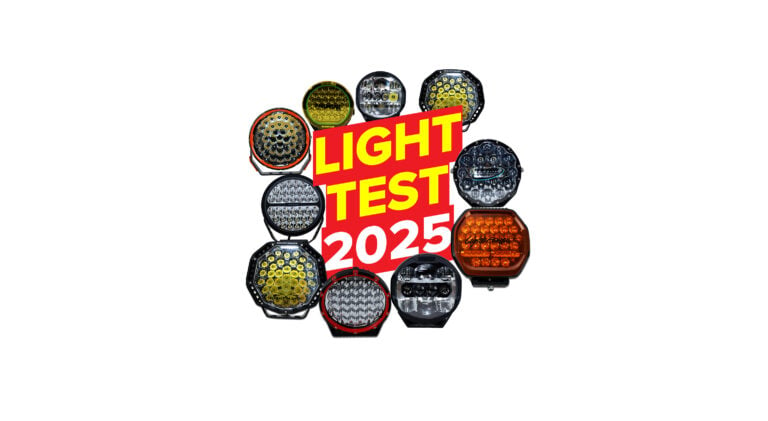 Gear
GearLED driving light shootout: Brightest beams for your 4x4 in 2025
We put the latest LED driving lights to the test to find which beams shine brightest and farthest for serious off-road and touring use
-
 Gear
GearIgnite 9-inch slimline laser LED driving light released
Ignite’s new 9-inch slimline laser LED driving light will enhance your night driving experience
-
 Gear
GearLightforce unveils BEAST LED driving lights
Lightforce has revealed its latest driving light innovation

